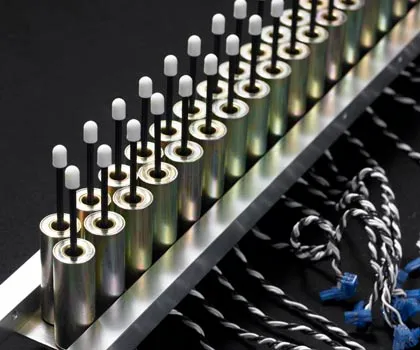A player system is a mechanism that is installed in a piano which allows the piano to play itself. Modern player systems can also offer other features such as recording and musical accompaniment.
A Brief History
The Pianola
Edwin Scott Votey created the first musical piano playing device in his workshop in Detroit in 1895. Though other piano playing devices existed at the time, Votey was the first to combine several different technologies into a practical device which produced musical results. He soon joined the Aeolian Company, which started selling his device, called the Pianola, in 1898.

Unlike the player systems of today, the Pianola sat in front of the piano and played the keys with felt-covered mechanical fingers operated by a pedal! Since it operated outside of the piano, the technical term for the Pianola was actually “piano player”. However, the Pianola was so successful that Pianola became a generic term for any player system, and the Aeolian Company even took competitors to court for trademark infringement for using it. Soon after the Pianola hit the market the technology was adapted to operate inside the piano, and this instrument became known as a “player piano”.


How It Works
The player piano version of the Pianola functions using a system of pneumatic tubes attached to the piano’s action. To play it you press foot pedals, which suck air out of the system and cause the hammers to hit the strings. A roll of paper with holes punched in it, or a piano roll, determines which notes play. While the Pianola lacks the expressiveness of a human piano player, it produces music at a satisfactory level, and is a fascinating piece of machinery. In addition, the Pianola doesn’t interfere with the normal functioning of the piano, so the piano in which it is installed can still be used as a conventional instrument. Here is a brief overview of how it works:
The Reproducing Piano
The next important innovation in player system technology came from Edwin Welte, who developed the world’s first reproducing piano, called the Welte-Mignon. The Welte-Mignon also used suction to operate, but it could automatically reproduce the performance of elite piano players, including the pedalling, tempo, phrasing, and dynamics. This was done by a sophisticated method of transferring the performance to a piano roll. The device was powered by suction, like the Pianola, but unlike the Pianola, it was not attached to a conventional piano. It was more like a cabinet you would find in someone’s living room.

This is a piano roll created by Carl Reinecke, the earliest born piano player to record. He was born in 1824, three years before the death of Beethoven!
Modern Player Systems
Modern player systems combine the concept of the Pianola with the concept of the Welte-Mignon. They are installed inside a fully functional conventional piano and can play prerecorded performances with an expressiveness that rivals that of the original. There is no need to use suction or piano rolls anymore, and the equipment required to make it work takes up much less space. Modern systems operate using electricity and digitized music libraries which can be accessed via the internet. Some brands connect to speakers which can provide musical accompaniment to the piano.
These are the major brands in the player piano market today:
- PianoDisc
- Pianoforce
- QRS
- Steinway & Sons
- Yamaha
How It Works
Instead of suction and a pneumatic tube that causes the hammer to move, modern systems use electricity and a device called a solenoid, which is embedded in the key bed. There is a solenoid for each key, and it pushes up on the underside of the key, moving the hammer toward the string. This is what a modern grand player piano looks like without the action:

Since modern systems operate digitally, no piano roll is needed to provide the information for what to play. All one needs is access to a music library that is formatted to work with the instrument. Today’s manufacturers have their own libraries, and the systems often come with an iPad or some other device that is used to control them.
Retrofitting and Updating
With the exception of a few, modern player systems can be installed in most pianos after market. Systems can also be updated to use online music libraries instead of CDs, which was where the information was stored before the advent of the internet. Player system manufacturers offer technicians courses in installing and upgrading their systems, so you can probably find a certified technician who will do that kind of work near you.
Summary
Player piano systems have been giving people the ability to listen to live piano in their own homes on command for over a century. The technology evolved rapidly from pneumatic tubes and foot pedals to electricity and solenoids. Modern systems can not only play the piano for you, they can record your playing and play it back to you! They also have access to vast quantities of music and can be installed in your piano after market.


